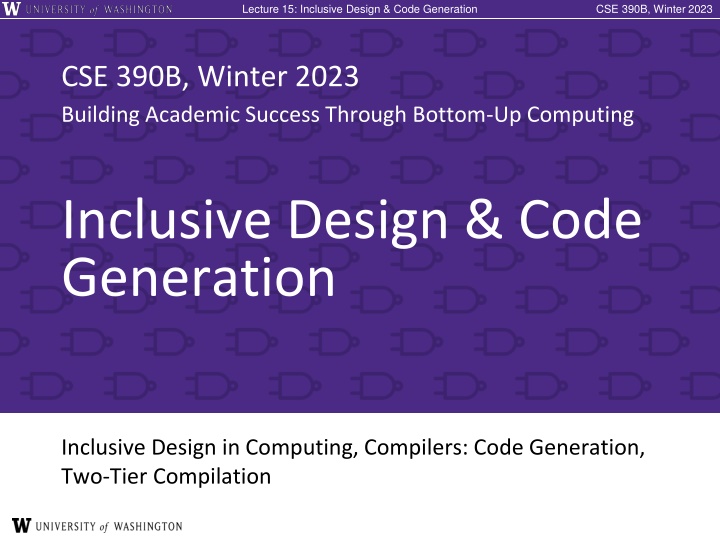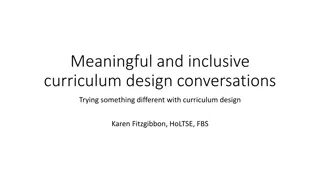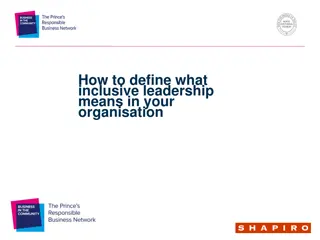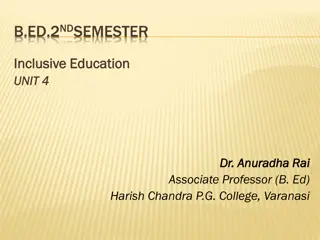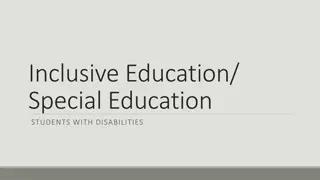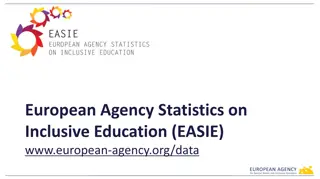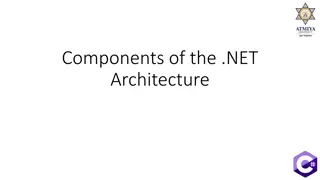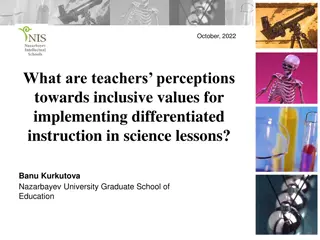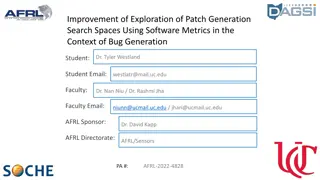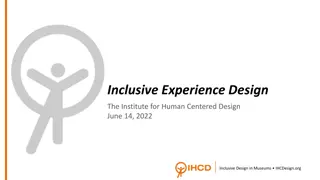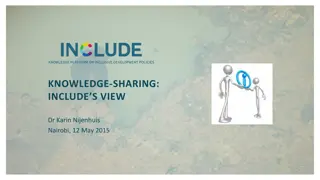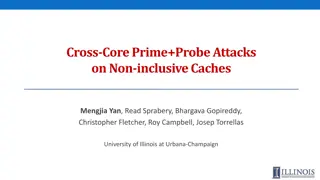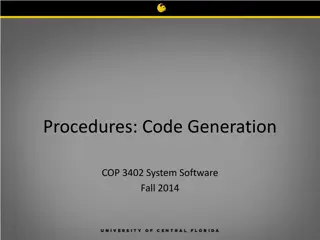Inclusive Design & Code Generation
The significance of design decisions in computing, focusing on creating positive interactions and mitigating negative impacts. Learn how intentional design can enhance user experiences and inclusivity in technology
Uploaded on Apr 04, 2025 | 2 Views
Download Presentation

Please find below an Image/Link to download the presentation.
The content on the website is provided AS IS for your information and personal use only. It may not be sold, licensed, or shared on other websites without obtaining consent from the author.If you encounter any issues during the download, it is possible that the publisher has removed the file from their server.
You are allowed to download the files provided on this website for personal or commercial use, subject to the condition that they are used lawfully. All files are the property of their respective owners.
The content on the website is provided AS IS for your information and personal use only. It may not be sold, licensed, or shared on other websites without obtaining consent from the author.
E N D
Presentation Transcript
Lecture 15: Inclusive Design & Code Generation Lecture 15: Inclusive Design & Code Generation CSE 390B, Winter 2023 CSE 390B, Winter 2023 CSE 390B, Winter 2023 Building Academic Success Through Bottom-Up Computing Inclusive Design & Code Generation Inclusive Design in Computing, Compilers: Code Generation, Two-Tier Compilation
Lecture 15: Inclusive Design & Code Generation CSE 390B, Winter 2023 Lecture Outline Inclusive Design in Computing Understanding Design and Its Importance Design Decisions in Computing Compilers: Code Generation Generating Target Code from an AST Two-Tier Compilation Intermediate Programs and The Java Virtual Machine (JVM) 2
Lecture 15: Inclusive Design & Code Generation CSE 390B, Winter 2023 What is Design? The way something works, including how someone uses it Almost always includes some element of interaction Design could have different definitions, goals, and interpretations in different contexts It s also not always about the end-user of a product For example, you might design a codebase that s easier to maintain Everything we create has design, but there is a range to how intentional the design of something is Could be completely forgotten Could be focused on throughout the creation of something 3
Lecture 15: Inclusive Design & Code Generation CSE 390B, Winter 2023 Why Talk About Design? If design is the way something works, including how someone uses it, then it dictates the interactions between us and everything Those interactions have a range of consequences Positive: When you go to a website, and you are easily able to find all the information you need Unideal: If a person can t easily drink from a certain cup Harmful: If a person can t easily use emergency equipment 4
Lecture 15: Inclusive Design & Code Generation CSE 390B, Winter 2023 Why Talk About Design? Seemingly harmless interactions can have real impact on people, especially if repeated E.g., Unable to use any door you see will make you feel unwelcome How can we design to create more positive reactions for more people while mitigating negative interactions? Tough question in a world with so many diverse people What accountability should there be for more harmful interactions caused by the design of something? A significant question with a muddy web of answers 5
Lecture 15: Inclusive Design & Code Generation CSE 390B, Winter 2023 An Aside: Bias Biases are the beliefs we have, often formed by our experiences Can be explicit: We consciously have a belief about something and it may intentionally impact us Can be implicit: Unconscious or impact us unintentionally We all have bias, and it is not inherently good or bad Both potentially beneficial and potentially harmful consequences Eliminating bias is not a realistic goal Attempting to mitigate negative consequences that come from bias is more realistic 6
Lecture 15: Inclusive Design & Code Generation CSE 390B, Winter 2023 Designer s Bias People often think of the typical user as someone who is similar to them or those they are close to An example of the influence of their biases Even if we try to think beyond what is familiar to us, it is unlikely we will remove bias from the design process Opinions about what something should do are inherently biased Ideally, we would develop processes that mitigate the negative effects of biases as much as possible Recall biases can be both known (explicit) and unknown (implicit) 7
Lecture 15: Inclusive Design & Code Generation CSE 390B, Winter 2023 Bias and Design Following slides include some ideas and frameworks people have come up with related to bias and design Not meant to be the most important ideas Think of it more as a few reference points that you can learn more about beyond this lecture Discussions about bias and design are very nuanced and constantly evolving None completely solve these issues, but they can be used to think about them and build better practices 8
Lecture 15: Inclusive Design & Code Generation CSE 390B, Winter 2023 Universal Design Big idea: Design things that can be used by as many people as easily as possible Designing things that work well for a wide range of people includes those who might usually be excluded For example: Video captioning The process of including everyone leads us to better design 9
Lecture 15: Inclusive Design & Code Generation CSE 390B, Winter 2023 Inclusive Design Including as diverse a range of perspectives when designing something as possible Similar to universal design, but you may offer different solutions for different types of people (rather than one solution for all) Including a diverse perspective does not just mean having a diverse team of people It means valuing a diversity of opinions and experiences If we prioritize diverse perspectives, especially those that have been typically excluded, it will lead to things that benefit more people 10
Lecture 15: Inclusive Design & Code Generation CSE 390B, Winter 2023 Affordance Theory Way of thinking about things around us Things provide different affordances to people A way of defining what the capabilities of something are Can group these affordances into different categories: What affordances does someone think/perceive something provides them? What affordances does something actually provide someone? 11
Lecture 15: Inclusive Design & Code Generation CSE 390B, Winter 2023 Affordance Types Four types of affordances (in reality, it s more of a spectrum) Perceptible affordance: something does what someone thinks it can Hidden affordance: something does what someone thinks it can t False affordance: something doesn t do what someone thinks it can Correct rejection: something doesn t do what someone thinks it can t 12
Lecture 15: Inclusive Design & Code Generation CSE 390B, Winter 2023 Design Principles in Practice In groups, discuss the following questions: Observations of design in the real world Experiences you have had with technology that has privileged or discriminated against you How might you design these technologies differently to be more inclusive? 13
Lecture 15: Inclusive Design & Code Generation CSE 390B, Winter 2023 Design in Computing Design discussions are relevant to computing Many were developed with design in mind Technology can be biased Design is part of almost everything in computing Our biases influence the design of things The computer science field has a lack of diversity This lack of diversity has led to many harmful designs 14
Lecture 15: Inclusive Design & Code Generation CSE 390B, Winter 2023 Design in Computing: Accessibility There is a large community in CSE focused on making technology more accessible for people E.g., making web pages easily navigable for people who are blind E.g., expanding internet access to remote populations Connection: Elements of both universal design and inclusive design Universal design: Designing products that work for as many people as possible Inclusive design: Including more perspectives in the design process, and potentially developing specific solutions aimed at including different groups of people 15
Lecture 15: Inclusive Design & Code Generation CSE 390B, Winter 2023 Design in Computing: Algorithmic Bias Research related to bias in AI/ML algorithms E.g., Facial recognition technology not working as well on people of color (trained on primarily white datasets) E.g., Racial bias in crime prediction algorithms (reflects the bias of our criminal justice system) These results biases reflect biased design decisions throughout development Picking datasets biased towards certain communities Testing applications in biased environments Bias in what is prioritized within an algorithm 16
Lecture 15: Inclusive Design & Code Generation CSE 390B, Winter 2023 Moving Towards Inclusive Design Design is often categorized as being separate from other parts of the development process In reality, happens in almost every stage of developing something You can voice feedback and concerns in design You are ultimately contributing to the design of it What conversations already occur, then ask how we can do better Different vision of how to approach building technology Slogan offered by Animikii: Move slow and empower people 17
Lecture 15: Inclusive Design & Code Generation CSE 390B, Winter 2023 Next Steps in Design Brief overview of design that only scratches the surface Entire fields and majors related to design and computing Human Computer Interaction (HCI) User Experience (UX/UI) Human Centered Design and Engineering (HCDE, major at UW) Related courses: CSE 340: Interactive computing CSE 440: Introduction to HCI SOC 225: Data and society HCDE department has some neat courses on this topic too! 18
Lecture 15: Inclusive Design & Code Generation CSE 390B, Winter 2023 Lecture Outline Inclusive Design in Computing Understanding Design and Its Importance Design Decisions in Computing Compilers: Code Generation Generating Target Code from an AST Two-Tier Compilation Intermediate Programs and The Java Virtual Machine (JVM) 19
Lecture 15: Inclusive Design & Code Generation CSE 390B, Winter 2023 Software Overview Java High-Level Language Python C/C++ Jack Compiler Intermediate Language(s) Java Byte Code Jack VM Code Compiler (Project 8) Compiler (VM Translator) Windows x86, x86-64 Mac Operating System Assembly Language ARM RISC-V HACK Unix/Linux Android Hack OS Assembler SOFTWARE Machine Code
Lecture 15: Inclusive Design & Code Generation CSE 390B, Winter 2023 The Compiler: Implementation public int fact(int n) { if (n == 0) { return 1; } else { return n * fact(n - 1); } } (fact) @R0 M=M+1 @R1 D=A @ifbranch D;JEQ High-Level Language Assembly Language Type Checker Code Generator Scanner Parser Optimizer Break string into discrete tokens: Arrange tokens into syntax tree: Verify the syntax tree is semantically correct Rearrange the code to be more efficient Convert the syntax tree to the target language IF ( ID(n) + == NUM(0) x 10 etc. 21
Lecture 15: Inclusive Design & Code Generation CSE 390B, Winter 2023 Code Generation: The Task @5 D=A @3 D=D+A PLUS left right NUM(5) NUM(3) Hack Assembly Abstract Syntax Tree Convert the AST into target language code that produces the same result Project 8 goal: Produce reliable, not efficient, compiler The tricky bit: Do it automatically for all possible arrangements of code To stay sane, we ll break the task down: Generate code for each node type in the AST 22
Lecture 15: Inclusive Design & Code Generation CSE 390B, Winter 2023 Compile Time vs. Run Time Compile Time Run Time @5 D=A @3 D=D+A PLUS let x = 5 + 3; Behavior right left NUM(3) NUM(5) Jack Hack Assembly Compiler (a Java program) is running Output (a Hack program) is running on the Hack computer Generates Hack instructions that will be run later Know value of variables, which code path is taken Know types of variables, but NOT the values of variables or which code path is taken 23
Lecture 15: Inclusive Design & Code Generation CSE 390B, Winter 2023 Code Generation: Example Here s how you, a brilliant human, would likely translate this syntax tree into Hack: @5 D=A @3 D=D+A Hack Assembly Human (genius) PLUS left right NUM(5) NUM(3) Abstract Syntax Tree 24
Lecture 15: Inclusive Design & Code Generation CSE 390B, Winter 2023 Code Generation: Example Here s how you, a brilliant human, would likely translate this syntax tree into Hack: @5 D=A @3 D=D+A Hack Assembly Human (genius) @5 D=A @R0 M=D // save R0 somehow PLUS left right NUM(5) NUM(3) @3 D=A @R0 M=D Computer (trying its best) Abstract Syntax Tree @R0 D=M // restore R0 @R0 MD=D+M 25 Hack Assembly
Lecture 15: Inclusive Design & Code Generation CSE 390B, Winter 2023 Code Generation: Example Why? Modularity: We can fit any expression in that slot, as long as its result ends up in R0! @5 D=A @R0 M=D NUM(2) PLUS // save R0 somehow Computer (actually, quite clever!) left right PLUS @3 D=A @R0 M=D NUM(5) NUM(3) NUM(3) Abstract Syntax Tree @R0 D=M // restore R0 @R0 MD=D+M 26
Lecture 15: Inclusive Design & Code Generation CSE 390B, Winter 2023 Code Generation: Example Why? Modularity: We can fit any expression in that slot, as long as its result ends up in R0! Even another ! PLUS @5 D=A @R0 M=D NUM(2) PLUS // save R0 somehow left right PLUS @3 D=A @R0 M=D NUM(5) PLUS NUM(3) left right NUM(1) NUM(2) @R0 D=M // restore R0 @R0 MD=D+M Abstract Syntax Tree 27
Lecture 15: Inclusive Design & Code Generation CSE 390B, Winter 2023 Code Generation: Example Now, we need to save R0 somehow What if we save it in a temporary register? Let s pick R2 @5 D=A @R0 M=D NUM(2) @R0 D=M @R2 M=D PLUS left right PLUS NUM(5) NUM(3) @3 D=A @R0 M=D NUM(3) Abstract Syntax Tree @R0 D=M // restore (reverse) @R0 MD=D+M 28
Lecture 15: Inclusive Design & Code Generation CSE 390B, Winter 2023 Code Generation: Example Now, we need to save R0 somehow What if we save it in a temporary register? Let s pick R2 @5 D=A @R0 M=D NUM(2) @R0 D=M @R2 M=D PLUS left right PLUS NUM(5) NUM(3) @3 D=A @R0 M=D NUM(3) Abstract Syntax Tree @R0 D=M // restore (reverse) @R0 MD=D+M Why won t this always work? 29
Lecture 15: Inclusive Design & Code Generation CSE 390B, Winter 2023 Code Generation: Example It s those pesky nested expressions! The outer PLUS saves a value in R2, but the inner PLUS overwrites that value during its computation @5 D=A @R0 M=D NUM(2) PLUS // save R0 in R2 PLUS left right @1 D=A ... // save R0 in R2 ... @R0 MD=D+M NUM(5) PLUS PLUS left right NUM(1) NUM(2) Abstract Syntax Tree @R0 D=M // restore R0 from R2 (!) @R0 MD=D+M 30
Lecture 15: Inclusive Design & Code Generation CSE 390B, Winter 2023 PLUS Code Generation: Example left right PLUS NUM(5) left right Solution: Store saved values in a stack Not quite the same as The Stack or function call stack frames (but used for a similar reason) We ll keep a stack starting at memory address 1024 R1 is our stack pointer: always stores address of last used stack position No built-in Hack push: manually copy to memory and increment R1 NUM(1) NUM(2) Abstract Syntax Tree @5 D=A @R0 M=D NUM(2) // push R0 to slot 0 PLUS @1 ... // push R0 to slot 1 ... // pop R0 from slot 1 @R0 MD=D+M PLUS @R0 D=M // pop R0 from slot 0 @R0 MD=D+M R1 1024 1025 1026 1027 1025 (R0) (R0) 31
Lecture 15: Inclusive Design & Code Generation CSE 390B, Winter 2023 Code Generation: Example What about variables? arr 256 var int arr[5]; var int bar, star; @261 D=M @262 M=D bar 261 let bar = star; star 262 Hack Assembly Jack screen 16384 Just like Assembler: Generate symbol table with mapping from variable names to spots in memory Arrays get more (contiguous) spots screen and keyboard are built-in array variables, allowing I/O 32
Lecture 15: Inclusive Design & Code Generation CSE 390B, Winter 2023 Code Generation: Takeaways Code Generation task: Writing several small snippets of Hack assembly But need to be very generalizable Whenever a PLUS expression is encountered, should generate almost the same code Conventions make the task much easier For example, after any expression code runs, result should always be stored in R0 Then parent code can depend on it 33
Lecture 15: Inclusive Design & Code Generation CSE 390B, Winter 2023 Lecture Outline Inclusive Design in Computing Understanding Design and Its Importance Design Decisions in Computing Compilers: Code Generation Generating Target Code from an AST Two-Tier Compilation Intermediate Programs and The Java Virtual Machine (JVM) 34
Lecture 15: Inclusive Design & Code Generation CSE 390B, Winter 2023 Software Overview Java High-Level Language Python C/C++ Jack Compiler Intermediate Language(s) Java Byte Code Jack VM Code Compiler Project 8 Compiler (VM Translator) Windows x86, x86-64 Mac Operating System Assembly Language ARM RISC-V HACK Unix/Linux Android Hack OS Assembler SOFTWARE Machine Code Real-World Examples Our Computer KEY:
Lecture 15: Inclusive Design & Code Generation CSE 390B, Winter 2023 Compiling Code: Single Tier High-Level Program Compiler for D Compiler for A Compiler for C Compiler for B Device A Device B Device C Device D 36
Lecture 15: Inclusive Design & Code Generation CSE 390B, Winter 2023 Compiling Code: Two Tier High-Level Program Compiler for VM Intermediate Program VM Translator for D VM Translator for A VM Translator for B VM Translator for C Device A Device B Device C Device D 37
Lecture 15: Inclusive Design & Code Generation CSE 390B, Winter 2023 The Java Virtual Machine (JVM) Java Code Java Compiler JVM JVM Runtime for D JVM Runtime for A JVM Runtime for B JVM Runtime for C Device A Device B Device C Device D 38
Lecture 15: Inclusive Design & Code Generation CSE 390B, Winter 2023 Post-Lecture 15 Reminders Project Reminders Project 7, Part I: Midterm Corrections due this Thursday (2/23) at 11:59pm (no late days may be used) Project 7, Part II: Professor Meeting Report due next Thursday (3/2) at 11:59pm Eric has office hours after class in CSE2 153 Feel free to post your questions on the Ed board as well 39
